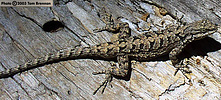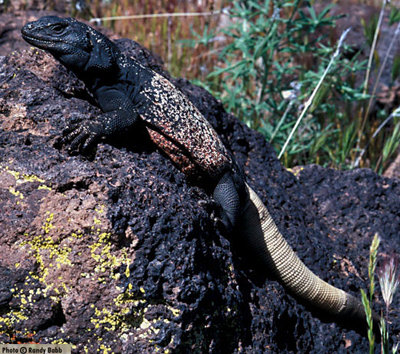

Copyright 2003 Tom Brennan. Urosaurus ornatus;
Common Name: Ornate Tree Lizard.
An Introduction to Lizards
- Who are they?
- Lizard Phylogeny
- What are they?
- Where are they?
- Sonoran Desert Lizards
- Adaptations
- Talking Lizards/List of Social Behaviors
- Lizard Behavior Movies!
- Habitats
- Foraging Patters
- Avoiding Predation
I. Who are they?
Lizards are reptiles, which means that they are related to snakes, crocodilians, turtles and tuataras. The Amniota page (mammals, reptles and their extinct relatives) depicts how lizards are related to snakes, crocodiles, turtles and tuataras. Reptiles evolved from amphibians somewhere around 315 million years ago and initally reptiles were small terrestrial creatures. Reptiles and amphibians are considered herpetofauna and are often referred to as 'herps'.
II. Lizard Phylogeny (How lizards evolved)
In the Phylogenetic Tree for Sarcopterygii (The lobe-finned fishes & terrestrial vertebrates) you can see that a long time ago reptiles and amphibians were part of a group of organisms called called Terrestrial Vertebrates. If you visit the Terrestrial Vertebrates page you can see how the reptiles split from living amphibians into a group of organisms called Amniota (reptiles, birds, mammals, dinosaurs, etc.) somewhere around 315 million years ago. If you continue to follow the evolution of lizards you will want to click on links in the tree and go from Amniota to Diapsida (Lizards, Sphenodon, crocodylians, birds, and their extinct relatives) and from there to Lepidosauromorpha (Lizards, snakes, Sphenodon, and their extinct relatives) and finally to Squamata (lizards and snakes). Squamata is the primary group to which this treehouse is attached.
III. What are they?
Lizards are ectothermic (“cold-blooded”) vertebrates with dry scaly skins, a tail, and usually four limbs with claws at the ends of their toes. Worldwide, lizards range from 1" to 10' in length and up to 300 or more lbs. in weight. Some are terrestrial (ground dwelling), others are arboreal (climb trees, shrubs), while certain forms are fossorial (under ground) and others are semiaquatic. They have internal fertilization (males actually have two penises called hemipenes) and most female lizards lay eggs, though several species bare live young. Some species will only live two to three years while others may live 50 years or more (and the closely related tuatara may live over 75-100 years). There are two venomous species of lizards, the Gila monster and the beaded lizard. They are both found in the Sonoran Desert region, though only the Gila monster is found in the United States. The beaded lizard is found only in Mexico and Guatemala.
IV. Where are they?
The 3,751 or so species of lizards are spread out over the globe, with representatives as far north as southern Canada and as far south as the tip of Argentina. One species is found above the Arctic Circle in Norway and others are found as far south as New Zealand. Different lizard forms occur from sea level up to 16,500 ft in elevation.
V. Sonoran Desert Lizards
The Sonoran Desert is a unique ecosystem that is home to lizards with unique adaptations. There are over sixty-five species of lizards found in the southwest, ranging from the miniscule, short-lived Side-blotched lizard (Uta stansburiana), to the moderate-sized and long-lived Gila monster (Heloderma suspectum). In the Tucson area, you might run into well over a dozen species, but are most likely to encounter whiptails, zebra-tailed, side-blotched and some spiny lizards.
V. Adaptations
Some lizards, like the chuckwalla (Sauromalus obesus) are well adapted to desert living.
 |
| Shown above: Sauromalus obesus (Common Chuckwalla), Maricopa County, AZ |
The Chuckwalla is a herbivore with a major attraction to rocky hillsides below elevations of 4000 feet. The body temperature of this medium-sized lizard has been documented up to 102°F, which allows it to be active at much higher temperatures than many other lizards. When it is too hot it will pant and take refuge from the heat, which for chuckwallas means diving into nearby rock piles or small caves. Its somewhat flattened body allows it to go into rock crevices and then small, rough scales combined with super-inflation of the lungs (up to 3 times their normal volume) make it virtually impossible to remove. The chuckwalla is a typical lizard in that it passes pasty uric acid instead of urine, which conserves valuable water. But this species goes a couple of extra steps, for it possesses nasal salt glands which allow it to rid its body of excess salts without using up precious water in the process. It can also determine the water content of plants that it consumes, and when the water content is too low, it stops eating them. Another intriguing feature of the chuckwalla is its lateral lymph sacs that allow it to store excess fluids, which means that when there’s extra water it can save it for many non-rainy days!
VI. Lizard Behavior: Talking lizards?
Most of the lizards found in the Sonoran Desert have a suite of behaviors used in a social context – in other words; it is one of the main ways that they communicate. Such behaviors, listed below, may be used intraspecifically (within a species) in the act of courtship (generally males courting females). Both intra and interspecific (between species) can occur as well. For example, an agonistic (aggressive) display usually between males (though in some species female to female interaction occurs as well) of the same or different species is a social behavior that lizards use to communicate.
An inventory of a species social behavior may include:
| Social Behavior | Description |
| Gape | an open-mouth display |
| Lunge | movement briefly and rapidly toward another animal |
| Chase | Rapid pursuit of another lizard |
| Bite | Using the mouth to grasp another animal (used in aggression and during mating) |
| Inflate | puff up body or throat |
| Arch (back) | raise the back vertically, often accompanied by a sucking in of the sides of the body; both of these make the animal appear larger than they truly are |
| Head-bob | up and down bobbing of the head |
| Pushup | up and down bobbing of the body (can be with all four legs or front legs only) View a movie of push up behavior. |
| Dewlap | extend a gular flap (piece of skin under the throat) downwards |
| Shudder or shuddering nod | several nods of head or slight bobs of the entire body |
| Tail raise | female raises base of or entire tail, generally indicates receptiveness to mating |
A male lizard, to assert dominance over another male, uses several of these behaviors. Many of these behaviors are ritualized, wherein they are used to challenge one another without any physical contact following it, which may serve to reduce or eliminate physical injury. In addition to these, many lizards use femoral pore secretions to mark territories. While this is primarily considered to be a way of conveying chemosensory information, some species may be able to recognize where other lizards have been by “seeing” the secretions. In fact, desert iguana secretions fluoresce under UV light, and a portion of their vision is within the UV spectrum, which allows them to see these secretions as markers. We are trying to find a website to reference that would show these behaviors in pictures.
View Lizard Behavior Movies:
 View Greater Earless Lizards doing push ups
View Greater Earless Lizards doing push ups
 View Lesser Earless Lizard eating cricket
View Lesser Earless Lizard eating cricket
VII. Habitats
The Sonoran Desert has a variety of habitats where lizards can be found, including grasslands, woodlands and forests, desert-scrub, etc. Incredibly, many of these habitats are found in or near Tucson. Most likely, your school is (or was) surrounded by Arizona-Upland desertscrub (with saguaros, cholla and prickly pear cacti, and paloverde, ironwood, and acacia trees, etc.) However, a short drive up the Mount Lemmon highway takes you through manzanita, oak and juniper woodlands, pine-fir forest and riparian zones, too. You can find different lizards in all of these areas. Keep in mind that they also use different microhabitats (habitat within a habitat). Within a given habitat one may find several microhabitats, which are smaller areas with distinct characteristics that create a unique place to live. These differences may be obvious, such as trees versus rocks, or subtle like a certain kind (limestone vs. granite, etc.) or size of rock, or different rock crevices with certain thermal (heat) characteristics.
VIII. Foraging Patterns
Some lizards are “sit-and-wait” species, some are active hunters and some do a little of both. For example, horned lizards tend to let their prey (ants) come right up to them, while a whiptail lizard will chase some of their prey down (adult insects and small lizards) or dig it up (grubs).
 View Lesser Earless Lizard eating cricket
View Lesser Earless Lizard eating cricket
XI. Avoiding Predation
Biologically, to be a successful lizard, you have to live long enough to make babies, which may take only one season or several years. To manage this the lizard has to eat and avoid being eaten. The following table lists the general method that lizards use to avoid being eaten.
| General Method | Specific Action |
| Avoidance |
|
| Offense |
|
| Body morphology |
|
| Offering a Sacrifice |
|



 Go to quick links
Go to quick search
Go to navigation for this section of the ToL site
Go to detailed links for the ToL site
Go to quick links
Go to quick search
Go to navigation for this section of the ToL site
Go to detailed links for the ToL site